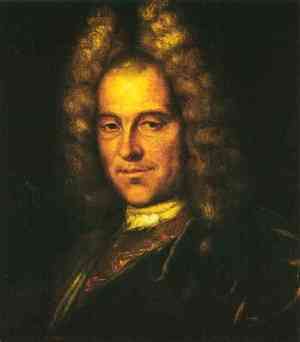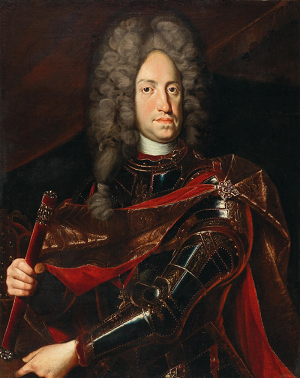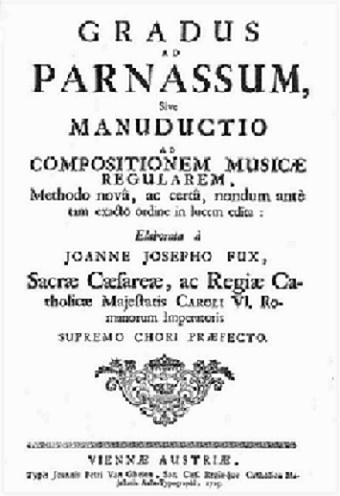


Johann Joseph Fux
Source:
Wikipedia
Born circa in 1660 in Austria, Johann Joseph Fux (pronounced just as) was a popular and solid composer of the baroque who became wealthy during a career of supplying music to Holy Roman Emperors. By the time of his first publications baroque, originating in Italy, had been around for a century. "K" numbers for Fux are per the Ludwig von Köchel directory of 1872, the same who indexed Mozart in 1862. This is 'Thematisches Verzeichniss der Compositioner von Johann Josef Fux' in 'Johann Josef Fux, Hofcompositor und Hofkapellmeister der Kaiser Leopold I., Josef I. und Karl VI. von 1698 bis 1740' printed in Vienna. This is a thematic rather than chronological system beginning with K 1 through K 50 being 50 Missas. Köchel catalogues Fux' sacred and secular works through K 405 which is the last of eight works for clavier. Fux is thought to have begun composing in 1680. His latest dated work was for Vespers, K 68 of 1732, which doesn't translate into a final work since a considerable portion of them are of unknown date.
Very probably receiving musical instruction as a youth, at age twenty Fux enrolled at the Jesuit university in Graz, Austria. The next year in 1681 he was advanced to the Jesuit school for gifted students at that university, the imperial Ferdinandeum. In 1683 he was enrolled at the Jesuit University at Ingolstadt in Bavaria (Germany).
From 1685 to 1688 Fux was organist at St. Moritz in Ingolstadt. He traveled to Italy for a time before stationing himself in Vienna during the early nineties. He was there appointed to the the court of Holy Roman Emperor Leopold I in 1698. He is known to have traveled to Rome in 1700 to study, perhaps on Leopold's tab, and might well have met Scarlatti, Corelli and Handel while there. Returning to Austria, Fux remained in service to Leopold, then his two Habsburg successors, Joseph I as of 1705 and Charles VI as of 1711.

Holy Roman Emperor Leopold I
Patron of Fux 1698-1705
Painting: Benjamin von Block 1672
Source: Wikipedia

Holy Roman Emperor Joseph I
Patron of Fux 1705-1711
Painting: Frans van Stampart 1705
Source: Wikipedia

Holy Roman Emperor Charles VI
Patron of Fux 1711-1740
Painting: Jacob van Schuppen Posthumous 1750+
Source: Wikipedia
To begin at the begin by opus number is to commence this presentation with Fux' Op 1 of 1701 that is 'Concentus musico-instrumentalis' containing K 351-357 which are two sinfonie, a serenade and four ouvertures dedicated to Prince Joseph prior to becoming Emperor.
'Overture in G minor' K 355 Johann Joseph Fux
From 'Concentus musico-instrumentalis' (Op 1) Pub Nuremberg 1701
Il Fondamento / Paul Dombrecht
Also arriving about 1701 was 'Sinfonia a 3' in C major, K 331, for two violins and basso continuo. This suite of eight some minutes in four parts addresses the major Habsburg victory upon the failed Ottoman siege of Vienna in 1683. Excepting Venice, the Habsburgs in northern Europe and Spain were Rome's first wall of defense against encroaching Islam. This set of dances is an early marker of what would become known as Janissary music which borrowed from the Turkish military band known as Mehter.
'Sinfonia a 3' in C major K 331 Johann Joseph Fux
Written for 2 violins / violone c 1701
Satz 1: 'Turcaria'
Satz 2: 'Passacaglia'
Satz 3: 'Janitschara'
Satz 4: 'Posta Turca'
Ars Antiqua Austria / Gunar Letzbor
Fux wrote about twice as much sacred music as secular, the latter including eighteen operas from 1702 to 1708. 'Julo Ascanio, Re d'Alba' K 304 premiered at the Hoftheater in Vienna on 19 March 1708 with a libretto by Pietro Antonio Bernardoni.
'Julo Ascanio, Re d'Alba' K 304 Opera by Johann Joseph Fux
Premiere at the Hoftheater in Vienna 19 March 1708
Libretto: Pietro Antonio Bernardoni
Ars Antiqua Austria / Ascanio: Markus Forster (alto) 2004
Fux' major claim to fame is the pedagogical tome addressing counterpoint, 'The Gradus Ad Parnassus' ('Steps to Mount Parnassus'). Written in Latin, it was published in 1725 to become a principal theoretical work used by J.S. Bach, Joseph Haydn, Mozart and Beethoven.

Gradus ad Parnassum 1725
Source: Wikipedia
In circa 1728 Fux completed one of his numerous works distinctive for trombone, the hymn from 'Psalms', 'Alma redemptoris mater' K 186.
'Alma redemptoris mater' K 186 Marian antiphon by Johann Joseph Fux
For voice and trombone circa 1728
Capricornus Ensemble Stuttgart
Soprano: Lydia Teuscher Trombone: Henning Wiegräbe
Fux's Miserere can be broadly dated to its inclusion in MS D-Dl Mus. 2130-D-5,2 transcribed by Jan Dismas Zelenka from 1730 to 1744, perhaps circa 1738. Numerous composers have set Miserere which derives from "Miserere mei, Deus" ("Have mercy on me, God") in 'Psalm 51'.
'Miserere' K 148 Johann Joseph Fux
Copied into MS D-Dl Mus. 2130-D-5,2 by Zelenka circa 1738
Capricornus Ensemble Stuttgart
Soprano: Lydia Teuscher Trombone: Henning Wiegräbe
Fux composed numerous works for solo clavier. 'Partita No.3' in A major is a gathering of six dances being an allemande, courante, gavotte, minuet (en rondeaux), sarabande and gigue. This is the last work in the Köchel directory as K 405. But Köchel isn't chronological and it isn't known when this partita for keyboard was completed.
'Allemande' No.1 of 6 of 'Partita No.3' in A Major K 405 Johann Joseph Fux
Harpsichord: Dorota Cybulska-Amsler
I wrap this presentation with a Mass being 'Missa Purificationis' K 28. Fux wrote about 80 works for Mass of which 43 included trombone. 'Purificationis' was written for two trombones, four voices (SATB), chorus (SATB), two violins and continuo. This is another composition of unknown date, at least insofar as I can find, albeit a year of 1700 is tempting to interpret at Alexander Street.
'Missa Purificationis' in D major K 28 Johann Joseph Fux
Written for 4 voices (SATB) / choir (SATB) / 2 trombones / 2 violins / continuo
Comp 1700?
Vorau Augustine Church Choir / Johann Pichler 15 August 2014
Fux' Austrian patron, Charles VI, died on 20 October 1740, succeeded by Charles VII. Fux followed about four months later on 13 February 1741, concluding sixty years worth of compositions.
Sources & References for Johann Joseph Fux:
Stephen Kingsbury (All Music)
Aryeh Oron (Bach Cantatas)
VF History (notes)
Audio of Fux: Classical Archives Internet Archive
Compositions / Works / Verseichnisse:
By date / Köchel: Klassika
By digitized copy / Köchel / title: Fux Online
By genre: Klassika ReciClassiCat
By genre / Köchel:
IMSLP Klassika Klassika Musik Addict
By Köchel / title:
Compositions: Individual:
Alma redemptoris mater (K 186 / Marian antiphon for voice and trombone / c 1728)
Digital Copies (see also Publications):
BD-Dl Mus. 2130-D-5,2 containing Miserere K 148 / Zelenka / 1730-1744:
Concentus Musico-instrumentalis (Op 1 / 1701)
Janissary music (military originating in Ottoman Turkey):
Britannica CNX Luis Dias Republic of Turkiye Zekeriya Şen
The Miserere (setting for Psalm 51):
William Smyth Rockstro (Dictionary of Music and Musicians / 1900)
Publications:
Gradus ad Parnassum (Fux / counterpoint / Wien 1725):
Internet Archive Munich DigitiZation Center A.V. Serzhen
Johann Josef Fux, Hofcompositor und Hofkapellmeister der Kaiser Leopold I., Josef I. und Karl VI. von 1698 bis 1740 (containing Thematisches Verzeichniss der Compositioner von Johann Josef Fux) / Ludwig von Köchel / 1872:
Begin Thematisches Verzeichniss (reduce) Begin K Catalogue (reduce)
Begin Thematisches Verzeichniss Begin K Catalogue
Recordings of Fux: Catalogs:
Discogs Music Brainz Naxos Presto RYM
Recordings of Fux: Select:
Complete Music for Harpsichord (Filippo Emanuele Ravizza / 2015 / Brilliant Classics 2017):
HighResAudio MusicWeb International Presto Qobuz
Concentus Musico Instrumentalis (Neue Hofkapelle Graz / Lucia Froihofer / Michael Hell / CPO 777 980-2 / 2015):
Scores / Sheet Music: Corpus:
Fux Online (digitized copies)
Scores / Sheet Music: Individual:
Missa Purificationis (K 28 in D major):
Internet Archive Musopen ScorSer
Further Reading:
Ronald Babcock (Study of Sonata a Quattro K. 347 and Alma Redemptoris Mater K. 186: Historical Significance as Works for Alto Trombone / U of North Texas 1994):
Michael Lorenz (Fux Documents 2016)
Talk Classical (discussion)
Bibliography:
Schenker Documents Online (Gradus ad Parnassum and Heinrich Schenker)
Authority Search:
BNF Data Deutsche Nationalbibliothek VIAF World Cat
Other Profiles:
Classical Main Menu Modern Recording
hmrproject (at) aol (dot) com